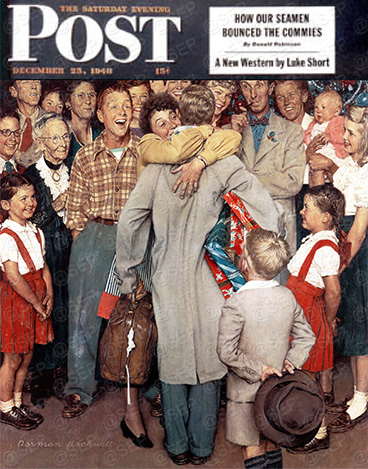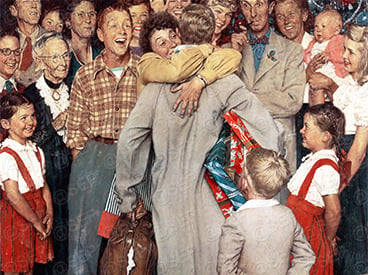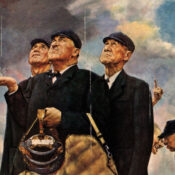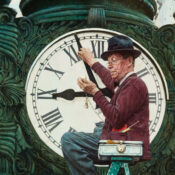
The Homecoming Norman Rockwell December 25, 1948
Parents will tell you nothing makes holidays more enjoyable than visits from their grown-up children. In 1948, Rockwell created his vision of a happy Christmas reunion by gathering all three of his boys in a single painting. We see the back of his oldest son, Jerry, receiving a joyful hug from his mother, Mary. To the left of Mary, in a plaid shirt, is son Tommy. Youngest son, Peter, appears on the far left wearing glasses. To Mary’s right, with that ubiquitous pipe, is happy Dad, who occasionally made cameo appearances in his paintings.
To make this scene of the homecoming even more joyous, Rockwell added friends and neighbors from his community in Arlington, Vermont. Many of these people appeared on other Rockwell covers, like the little boy holding the hat, who was the main character in Rockwell’s A Day in the Life of a Boy. Rockwell also used the boy’s baby sitter—the blonde girl on the far right—and his mother and baby brother, who was dressed in a pink sweater. The little girls in red jumpers are actually one girl—the daughter of Rockwell’s doctor—who was so cute, he painted her as twins.
Rockwell’s good friend and fellow Post artist, Mead Schaeffer, is at the very top left. His daughters, who posed for Rockwell are also shown: blonde Lee is just left of Norman, redheaded Patty, stands to the right of Tommy. And what family gathering is complete without a grandmother? Happy to pose for the role was none other than Grandma Moses, who started painting at 67. “When I knew her,” Rockwell wrote, “she was over 85 years old, a spry, white-haired little woman. Like a lively sparrow.”
Rockwell chose his subjects carefully. He wanted to create a scene both familiar and poignant, one that would resonate with families who had known recent (and lengthy) wartime separations. Even today, Rockwell’s homecoming evokes the spirit of welcome we’d like to see waiting for us when we come home for the holidays.
Become a Saturday Evening Post member and enjoy unlimited access. Subscribe now



